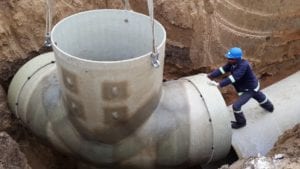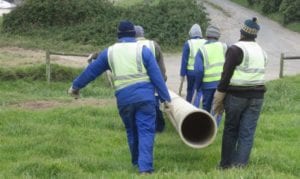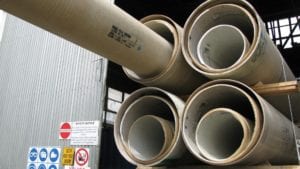Flowtite South Africa’s managing director, Bantu Mselana, shares the company’s strategic vision for resurgent growth in glass fibre reinforced pipe (GRP) in key sectors that include water, sanitation and gas pipeline delivery, building on Flowtite™ Technology’s long-established record as a preferred specification for municipal infrastructure worldwide.
 Flowtite Technology can trace its history back to the 1960s, when its predecessor, Vera Fabrikker, a Norwegian company, invented the world’s first continuous filament wound pipe. The system was patented in 1967. This paved the way for groundbreaking developments in GRP manufacturing technology and a successive series of proprietary innovations that has maintained Flowtite’s global leadership.
Today, Flowtite’s worldwide footprint is represented by a network of international manufacturing facilities. The centre of excellence remains housed at Flowtite Technology’s Sandefjord headquarters in Norway. Flowtite South Africa joined the group as a manufacturing licensee in June 2018, following the acquisition of locally based company Fiberpipe Holdings.
The deal was backed by funding from the Industrial Development Corporation, which has identified Flowtite GRP as a highly durable and cost-competitive solution for South Africa’s pressing infrastructure requirements. Historically, the introduction of Flowtite GRP in South Africa took place in the early 1990s. Locally, GRP was first manufactured by Flowtite Botswana for the Southern African market. The modernday factory, previously owned by Fiberpipe, is currently based in Germiston, Gauteng, and is now being expanded by Flowtite SA.
Flowtite Technology can trace its history back to the 1960s, when its predecessor, Vera Fabrikker, a Norwegian company, invented the world’s first continuous filament wound pipe. The system was patented in 1967. This paved the way for groundbreaking developments in GRP manufacturing technology and a successive series of proprietary innovations that has maintained Flowtite’s global leadership.
Today, Flowtite’s worldwide footprint is represented by a network of international manufacturing facilities. The centre of excellence remains housed at Flowtite Technology’s Sandefjord headquarters in Norway. Flowtite South Africa joined the group as a manufacturing licensee in June 2018, following the acquisition of locally based company Fiberpipe Holdings.
The deal was backed by funding from the Industrial Development Corporation, which has identified Flowtite GRP as a highly durable and cost-competitive solution for South Africa’s pressing infrastructure requirements. Historically, the introduction of Flowtite GRP in South Africa took place in the early 1990s. Locally, GRP was first manufactured by Flowtite Botswana for the Southern African market. The modernday factory, previously owned by Fiberpipe, is currently based in Germiston, Gauteng, and is now being expanded by Flowtite SA.
“Growing South Africa’s manufacturing sector is a key macroeconomic priority and, in this respect, Flowtite SA has an important role to play, particularly in terms of boosting local content fabrication and downstream job creation,” says Mselana. “We are proud to say that around 80% of our content is sourced in South Africa, with the exception of the highly specialised glass fibre composites, which are imported.”
 Flowtite GRP repositioning
Flowtite GRP repositioning
A top priority for Flowtite SA is to reposition and reinforce the value of Flowtite GRP, a standard technology globally, but one that has not achieved the same level of penetration it deserves in South Africa. Key reasons for this include misconceptions about GRP as a whole.
“Flowtite GRP cannot be placed in this pool of thought, as it is a far superior product that is manufactured under strict controls and quality procedures handed down from Flowtite Technology’s R&D Department in Norway, which is maintained through our Dekra ISO 9001:2015 certification. Our main aim is to separate the Flowtite Technology from the misconceptions of other GRP products,” Mselana continues.Flowtite GRP has been proven to beat steel, concrete and HDPE piping systems when it comes to longer-term durability, thanks to features that include its incredible non-corrosive properties. This is underscored by the fact that the typical lifespan for Flowtite GRP is up to 150 years, with minimal maintenance interventions required. Flowtite GRP is inherently flexible and virtually indestructible. Installations are also typically faster and more cost-effective compared to other pipe systems, due to Flowtite GRP’s lighter weight and custom-fit capabilities. The relatively lightweight properties of Flowtite GRP also lend themselves perfectly to labour-intensive construction and SME development, due to the smaller-scale plant required for some installations. “Flowtite Technology is very well established internationally but is still not well understood in South Africa. We’re here to change that and to demonstrate the long-term value of Flowtite GRP,” Mselane continues. “It is common knowledge that the construction industry is under pressure, and budgets are constrained; so, it’s vitally important that the market investigates alternatives. Flowtite SA assists in this respect by providing expert advice on material selection, quantities, training and on-site technical assistance. Maintenance training is also provided on request to maximise return on investment.”
 Complete solution
Complete solution
Flowtite GRP Technology systems provide a complete solution and are ideal for mainstream roles like water and sanitation, but the range of applications is virtually limitless and includes desalination, industrial and hydropower projects. A distinctive advantage is that Flowtite SA manufactures each pipe order to meet the exact project requirements. Flowtite SA GRP products range in diameters from 300 mm to 1 800 mm, and cater for pressures up to 32 bar. Larger Flowtite diameters – up to 4 m – are also available.
Flowtite also fabricates its own REKA couplings and fittings, which are made to clients’ specifications, and pipes can be cut on-site to fit exact lengths required. Another complementary offering is Flowtite’s manhole series for sewer lines. “We are investing some R120 million in upgrades at the factory so that we can provide 100% quality assurance,” he explains. The current manufacturing output capacity is around 800 m per day, or 5 km per week, with production taking place under strict international quality control standards and is licensed to produce pipes according to standards such as SANS 1748-1, AWWA C950, EN 1796, EN 14364, ISO 10639, ISO 10467, ASTM D3262, ASTM D3517 and ASTM D3754.
 Flowtite Grey
Flowtite Grey
New products being introduced include Flowtite Grey high-impact GRP, which takes durability to a new level. Flowtite Grey provides up to 10 times higher impact resistance than standard Flowtite GRP, and is also more resistant to abrasion and water jet. Higher impact resistance enables engineers to use larger backfill particles (up to 64 mm), including crushed rock, which lowers construction costs; improved abrasion resistance enables the fluid transfer of heavier loads of suspended solids.
“Standard Flowtite GRP is very robust; Flowtite Grey takes this to an unprecedented level, and we are introducing it as an alternative,” says Mselane. “This will further counter misunderstandings in the market that Flowtite GRP needs to be handled differently from other pipe systems in terms of its strength. Flowtite Grey will withstand the rigours of any construction market and forms part of our focus on driving imports into Africa.”Within Southern Africa, Flowtite GRP continues to form critical networks. A landmark project is Botswana’s North-South Carrier pipeline project, designed to transport raw water to Gaborone over a distance of approximately 360 km. Locally, Flowtite GRP applications include water pipelines in Mthatha, Eastern Cape, as part of the King Sabata Dalindyebo Presidential Intervention project, which is ongoing. Flowtite SA is also currently active in the Western Cape, Free State, Limpopo and neighbouring countries Zimbabwe and Namibia. “The market has responded very positively to the launch of Flowtite SA and we’re excited about working with public and private sector stakeholders to roll out the unique value our GRP offers,” Mselane concludes.








